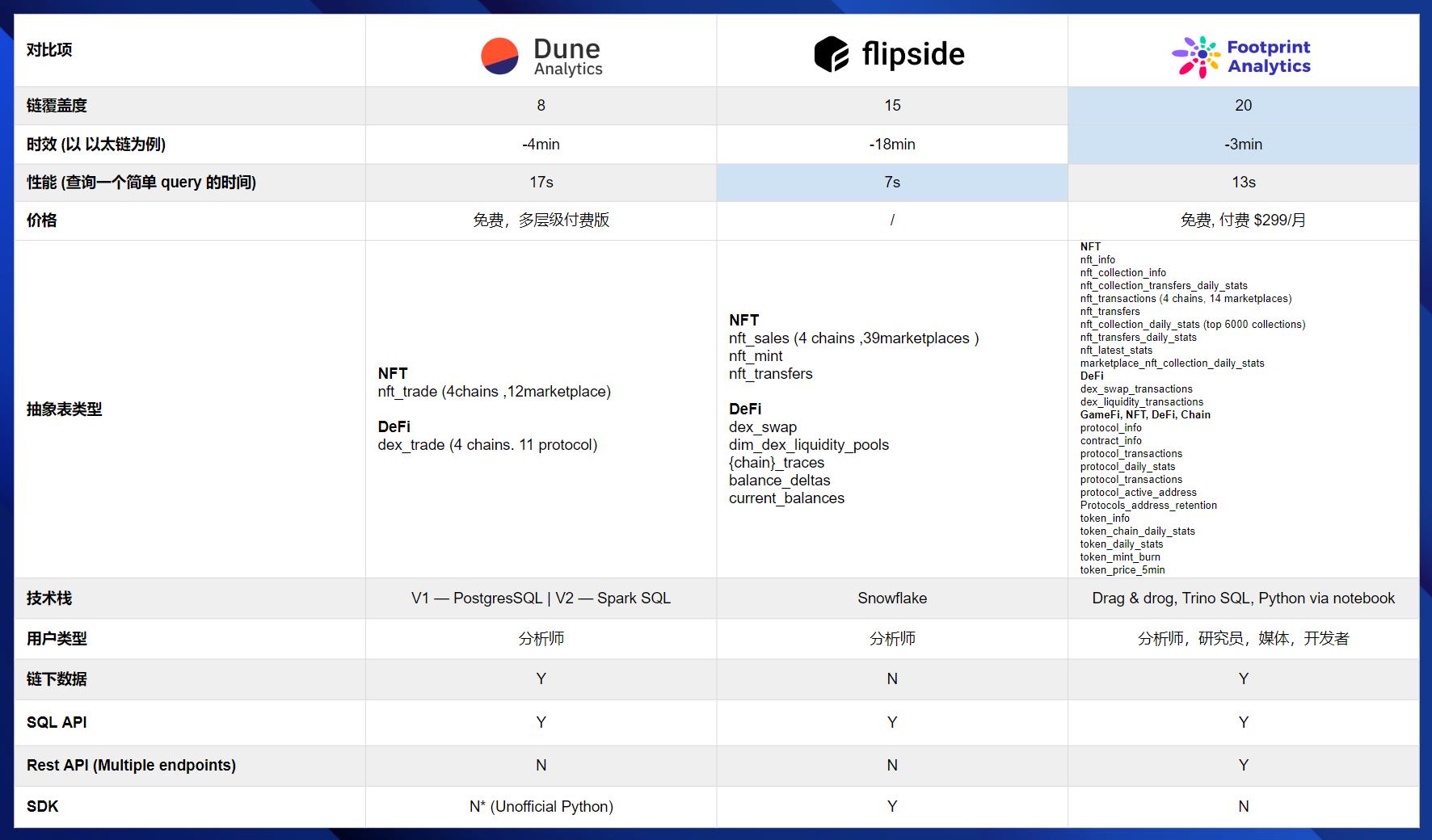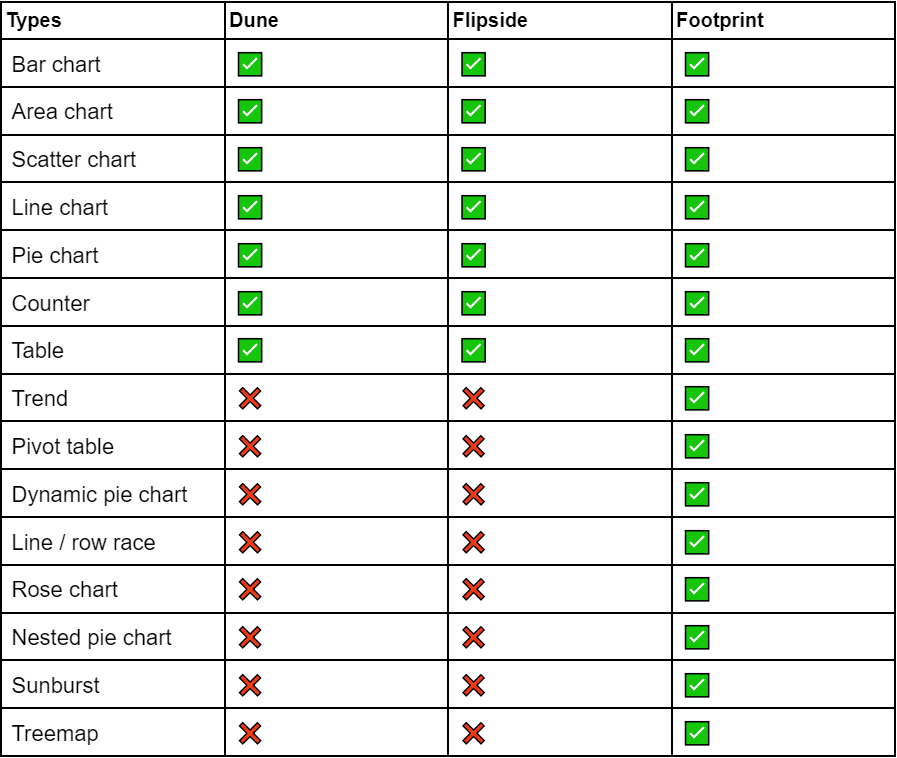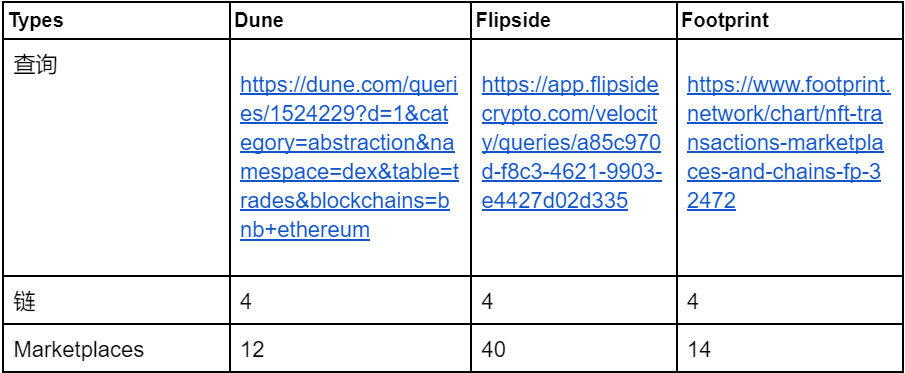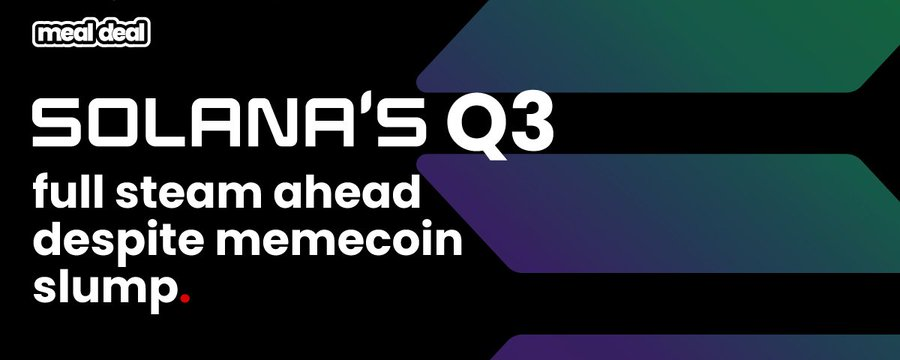Quickly compare the data analysis tools on the top chain in 5 minutes
Cryptocurrency analytics platforms enable people to gain deeper insights into chains, protocols, and projects in addition to tracking token and NFT prices. However, not all platforms and tools are created equal.
There is always a tradeoff between breadth and usability, system performance and flexibility, price and functionality, and so on. To help analysts choose the platform that best suits their needs, I did a trial comparison of three major cryptocurrency analysis platforms. they are, respectively:
Dune Analytics
Footprint Analytics
Flipside
11 Core Metrics Analysts Can Consider When Choosing the Tool That's Right for Theirm
Coverage of the public chain
Flexibility and Ease of Use
aging
performance
price
visualization options
data table type
Subdivided fields, such as NFT data, GameFi
technology stack
Offline Data Acquisition Capability
API access form
background
background
Many analysts have written many comprehensive comparison articles on analysis tools. In this post, I will only focus on cryptocurrency industry tools - that is, those tools that are specifically built to solve the problem of blockchain analysis.
Also, instead of addressing each software individually, I'll compare them side by side. If you or your team is focused on a specific problem, like finding the most affordable tool or the tool with the most NFT capabilities, you can skip right to that section.
chain coverage
Coverage refers to the number of public chains indexed by a tool, such as Ethereum, Solana, Boba Network, etc. However, it can also include depth - the amount of historical data covered by the public chain.
Data Engineer and Blockchain AnalystPrimo DataCreated the best up-to-date visualization comparing public chain coverage across different analytics platforms.
Among the top three cryptocurrency analysis platforms, Footprint Analytics has the widest coverage, currently covering 20 of the 43 public chains. Flipside came in second with 15, compared to Dune Analytics' eight.
If you only need to analyze one of a few major coins or chains, such as BTC, Solana, or Ethereum (all three offer it), coverage doesn't really matter.
However, in other areas such as GameFi, coverage becomes critical as many projects use their own small vertical chains such as DFK Chain, Ronin and Wax. Its breadth of coverage makes Footprint Analytics the go-to platform for GameFi analytics -- for example, it's the only one that offers underlying data for all three chains, as well as abstract data tables.
A balance between flexibility and ease of use
Due to the open source nature of web 3, it is relatively easy to build a blockchain ETL repository and make it available for users to explore at will. The difficulty lies in data parsing and analysis. For the vast majority of analysts (especially those who have entered web 3 from web 2), the transitional original data cannot be used, and they are very dependent on the existing community panels. On the other hand, the oversimplified dashboard of data indicators prevents more advanced teams from creating customized, purposeful analysis of what is behind the data.
All platforms are ultimately built on top of relational databases, which means SQL is used as the main tool. To use Flipside and Dune, knowledge of SQL is required, and Footprint designed an additional abstraction layer (a SQL query builder) on top of SQL, which is a drag-and-drop analysis interface. Although only simple SQL queries can be built through the user interface (currently does not support multi-statement queries, correlated subqueries, window functions), this is a great addition to the entire ecosystem as the barrier to entry for analysts becomes lower up.
aging
Aging refers to the length of time for updating data.
Analyst Carson Brown wrote in OctoberIn-Depth Comparison ArticlesIn , the data latency delay of each platform is compared. According to the results of his test, Dune is the leader among the 3 platforms, while Footprint Analytics is relatively behind in this respect, with a delay of about 1 hour.
Latency is clearly a serious issue, and on November 7th, Footprint announced some major upgrades. After the upgrade, the latest Ethereum block on each platform was queried again, and the following results were obtained.

performance
Performance refers to the speed at which users can query data. Especially for professional analysts or those who need to calculate indicators efficiently, the speed of the platform is crucial.
We used the same simple query for each platform - got the gas fee sum for the last 30 days and tracked the response time.

Currently, Flipside is the most responsive tool, followed by Footprint Analytics. Dune came in third with an invocation time of 17 seconds.
price

Both Dune and Footprint have free versions for beginners. There are also paid accounts available for advanced levels. The free version of Footprint also supports the Data API.


Flipside currently does not have a fee plan. It acts as an intermediary between projects (eg, Uniswap/SushiSwap/etc.), offering bounties on top of the infrastructure that provides analytics, with 55% split between the bounty and the analyst.
visualization
secondary title

data sheet
A good data model for blockchain analysis should meet the following criteria:
Reduce the number of table joins. Users should be able to quickly find analysis objects to join.
Reduce the cost of understanding. This requires that the analysis method be relatively general - this includes, for example, not needing to independently search for the necessary smart contract addresses; or clear aggregation of raw transaction data.
Optimize indexes. This is necessary to ensure that the table can be queried quickly.
Do not repeat information. Duplicating information in multiple tables can lead to inconsistencies and errors.
Ensure data integrity. This is done by using foreign keys and other database tools to ensure that no outliers exist.
Keep the data model as simple as possible. This is necessary to ensure that it can be easily extended and maintained.
secondary title

NFT data
If you are interested in NFT analysis, it is necessary to evaluate the coverage of each public chain and market before choosing a platform. The following query returns the corresponding numeric values.

As you can see, Flipside supports the most market spaces. Footprint, on the other hand, has business indicators such as wash trading (https://twitter.com/Footprint_Data/status/ 1578707786455666688 #msecondary title
technology stack
Fundamentally, the above platforms are built on relational databases. When it comes to billions and possibly trillions of rows in a database, one needs a scalable infrastructure.
secondary title

Off-chain data integration capabilities
When analyzing on-chain data, it is important to be able to compare with combined off-chain data. Dune and Footprint enable immediate uploading of own forms for analysis within their respective platforms.
text

API / SDK
text
text
Currently Flipside supports the official SDK. Supported programming languages are Python and R.

Dune:
https://dune.com/queries/ 1548542
Flipside:
Footprint:
https://www.footprint.network/chart/Latest-block-number-fp- 32685
https://www.footprint.network/chart/Gas-transactions-for-part-previous-days-grouped-by-day-fp- 32687
https://www.footprint.network/chart/nft-transactions-marketplaces-and-chains-fp- 32472



